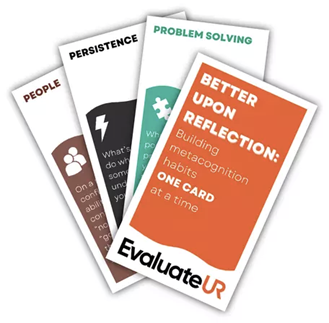by Lauren Scharff, U. S. Air Force Academy
As many of us educators know, an unfortunately large number of students, both at the K-12 and college-levels, do not give much thought to how and why they try to learn the way they do, much less demonstrate strong habits of metacognition. Talking in general about metacognition might garner some students’ interest, but without some concrete guidance on how to engage in behaviors that support metacognition, students are less likely to develop such practices.
Thus, I was pleased to rediscover the GAMES survey / self-assessment tool created by Marilla Svinicki when I was re-reading her excellent book, Learning and Motivation in the Postsecondary Classroom, as part of a book group at my institution. GAMES stands for:
- Goal-oriented studying
- Active studying
- Meaningful and memorable studying
- Explain to understand
- Self-monitor
For each component of the survey, there are five to ten behaviors for which students indicate their likelihood to perform using a 5-point scale ranging from “Never” to “Always.” These behaviors are distinct, tangible actions such as:
- Analyze what I have to do before beginning to study. (Goal-oriented studying)
- Ask myself questions before, during, and after studying. (Active studying)
- Make connections between what I am studying and past classes or units. (Meaningful and memorable studying)
- Discuss the course content with anyone willing to listen. (Explain to understand)
- Keep track of things I don’t understand and note when they finally become clear and what made that happen. (Self-monitor)
Marilla suggests that the use of such an instrument can help students become more aware of the possibility of self-regulating their learning behaviors. This combination of awareness and self-regulation is key to metacognition, and is what is prompting this blog post.
Through the process of completing the GAMES survey, students are introduced to more than 30 specific behaviors that holistically will support metacognition about learning. Students can easily observe areas where they might show stronger or weaker engagement, and they can focus their efforts where they are weaker, using the list of specific, tangible behaviors as a scaffold to help them target their activity.
At my institution, the U. S. Air Force Academy, we plan to use the GAMES survey in a current Science of Learning workshop series for our students led by students. Most of the seminar attendees are students who are struggling academically, but we are advertising that, by “studying smarter, not only harder” students of all levels of academic achievement can improve their learning. We believe that the GAMES survey will help students target specific behaviors that have been shown to support deeper learning.
We are not the only institution that has seen value in disseminating the GAMES survey to students. For example, several years ago, Georgia Tech encouraged its use across all sections of their first-year seminar. Importantly, they didn’t simply ask students to complete the survey and that was it. They encouraged instructors to help students use the results in a meaningful way, such as by picking a weak behavior and striving to improve it over a 2-week time period, or by having students journal about changes they made and how those changes seemed to impact their academic performance.
This survey tool is appropriate across the disciplines and only takes a few minutes for students to complete. Its use and a short follow-on activity to encourage meaningful application would not add great burden to a faculty member or take much time from normal course activities. But, the pay-off could be large for individual students, both in that course as well as others if they transfer the principles into new contexts. It’s definitely worth a try!
——————
Svinicki, M. D. (2004). Learning and motivation in the postsecondary classroom. Bolton, MA: Anker Publishing Co.
If you do not have access to Marilla Svinicki’s book, you can read a short online overview of GAMES on the Association for Psychological Science website (2006), and obtain a pdf copy of the survey online.



